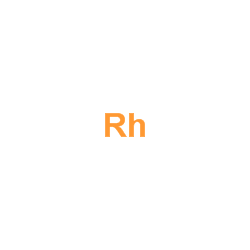Rhodium

Rhodium structure
|
Common Name | Rhodium | ||
|---|---|---|---|---|
| CAS Number | 7440-16-6 | Molecular Weight | 102.906 | |
| Density | 12.41 g/cm3 (lit.) | Boiling Point | 3727 °C(lit.) | |
| Molecular Formula | Rh | Melting Point | 1966 °C(lit.) | |
| MSDS | Chinese USA | Flash Point | N/A | |
| Symbol |

GHS02 |
Signal Word | Danger | |
|
Toxic impact of bromide and iodide on drinking water disinfected with chlorine or chloramines.
Environ. Sci. Technol. 48(20) , 12362-9, (2014) Disinfectants inactivate pathogens in source water; however, they also react with organic matter and bromide/iodide to form disinfection byproducts (DBPs). Although only a few DBP classes have been systematically analyzed for toxicity, iodinated and brominate... |
|
|
Synthesis and Temperature-Induced Structural Phase and Spin Transitions in Hexadecylboron-Capped Cobalt(II) Hexachloroclathrochelate and Its Diamagnetic Iron(II)-Encapsulating Analogue.
Inorg. Chem. 54 , 5827-38, (2015) Template condensation of dichloroglyoxime with n-hexadecylboronic acid on the corresponding metal ion as a matrix under vigorous reaction conditions afforded n-hexadecylboron-capped iron and cobalt(II) hexachloroclathrochelates. The complexes obtained were ch... |
|
|
Bio-inspired catalytic imine reduction by rhodium complexes with tethered Hantzsch pyridinium groups: evidence for direct hydride transfer from dihydropyridine to metal-activated substrate.
Angew. Chem. Int. Ed. Engl. 52(12) , 3411-6, (2013)
|
|
|
Lead exposure causes thyroid abnormalities in diabetic rats.
Int. J. Clin. Exp. Med. 8 , 7160-7, (2015) Lead is a widely-spread environmental pollutant and a commonly-used industrial chemical that can cause multisystemic adverse health effects. However, the effects of lead exposure on diabetic animals have not been reported so far. The aim of this study is to e... |
|
|
Gravimetric preparation and characterization of primary reference solutions of molybdenum and rhodium.
Anal. Bioanal. Chem 407(11) , 3093-102, (2015) Gravimetrically prepared mono-elemental reference solutions having a well-known mass fraction of approximately 1 g/kg (or a mass concentration of 1 g/L) define the very basis of virtually all measurements in inorganic analysis. Serving as the starting materia... |
|
|
Mouse genetic background impacts both on iron and non-iron metals parameters and on their relationships.
Biometals 28 , 733-43, (2015) Iron is reported to interact with other metals. In addition, it has been shown that genetic background may impact iron metabolism. Our objective was to characterize, in mice of three genetic backgrounds, the links between iron and several non-iron metals. Thi... |
|
|
Synthesis and characterisation of halide, separated ion pair, and hydride cyclopentadienyl iron bis(diphenylphosphino)ethane derivatives.
Dalton Trans. 44 , 14159-77, (2015) Treatment of anhydrous FeX2 (X = Cl, Br, I) with one equivalent of bis(diphenylphosphino)ethane (dppe) in refluxing THF afforded analytically pure white (X = Cl), light green (X = Br), and yellow (X = I) [FeX2(dppe)]n (X = Cl, ; Br, ; I, ). Complexes are exce... |
|
|
Site selective syntheses of [(3)H]omeprazole using hydrogen isotope exchange chemistry.
J. Labelled Comp. Radiopharm. 58 , 433-41, (2015) Omeprazole (Prilosec®) is a selective and irreversible proton pump inhibitor used to treat various medical conditions related to the production of excess stomach acids. It functions by suppressing secretion of those acids. Radiolabeled compounds are commonly ... |
|
|
Method validation and proficiency testing for determination of total arsenic in apple juice by inductively coupled plasma/ mass spectrometry.
J. AOAC Int. 97(4) , 1143-50, (2014) A proficiency test (PT) program for determination of total As in apple juice samples was conducted by the Food Emergency Response Network (FERN) laboratories. An analytical method using inductively coupled plasma (ICP)-MS was validated for this project. The L... |
|
|
Charge-controlled nanoprecipitation as a modular approach to ultrasmall polymer nanocarriers: making bright and stable nanoparticles.
ACS Nano 9 , 5104-16, (2015) Ultrasmall polymer nanoparticles are rapidly gaining importance as nanocarriers for drugs and contrast agents. Here, a straightforward modular approach to efficiently loaded and stable sub-20-nm polymer particles is developed. In order to obtain ultrasmall po... |